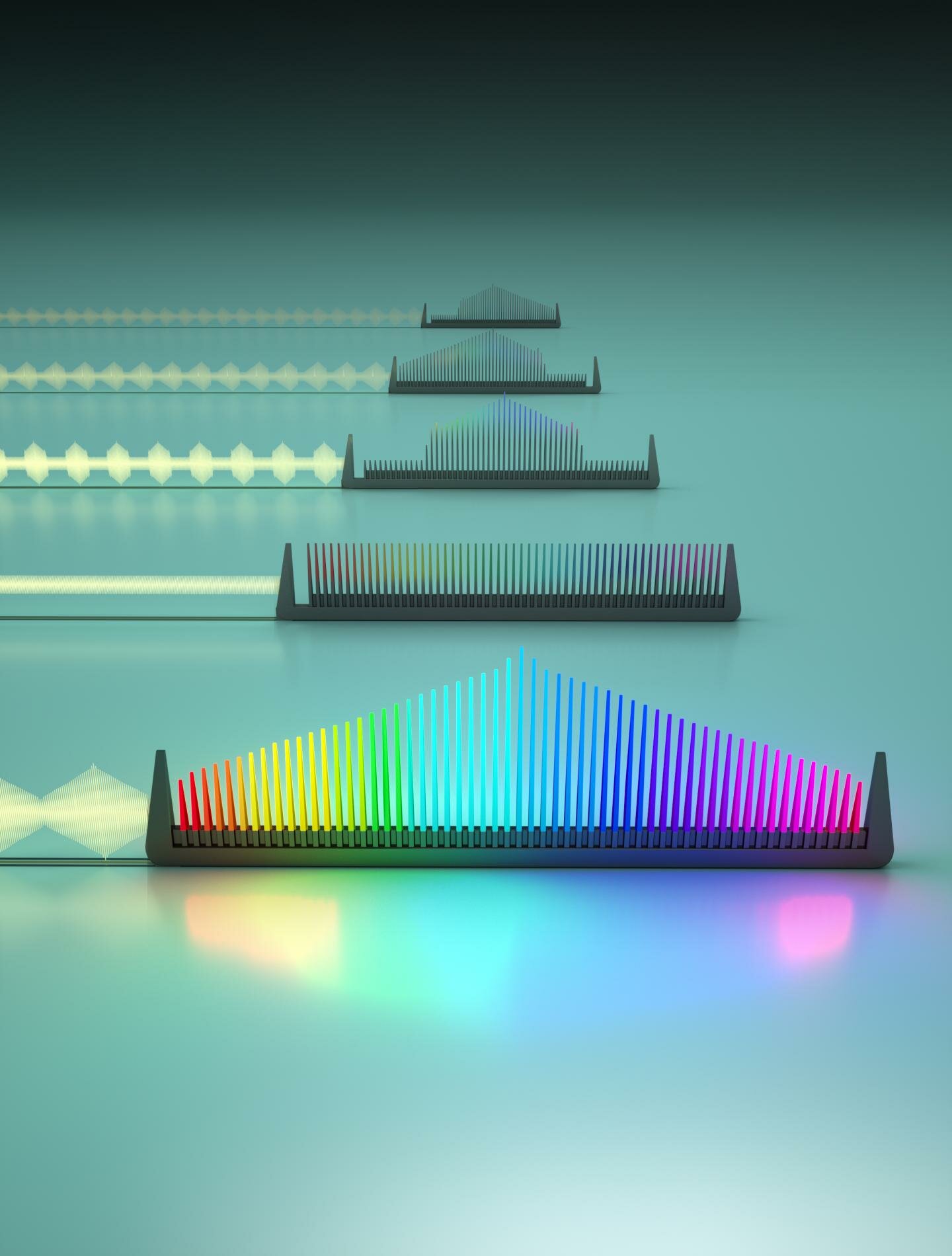Lasers play a vital role in everything from modern communications and connectivity to bio-medicine and manufacturing. Many applications, however, require lasers that can emit multiple frequencies—colors of light—simultaneously, each precisely separated like the tooth on a comb.
Optical frequency combs are used for environmental monitoring to detect the presence of molecules, such as toxins; in astronomy for searching for exoplanets; in precision metrology and timing. However, they have remained bulky and expensive, which limited their applications. So, researchers have started to explore how to miniaturize these sources of light and integrate them onto a chip to address a wider range of applications, including telecommunications, microwave synthesis and optical ranging. But so far, on-chip frequency combs have struggled with efficiency, stability and controllability.
Now, researchers from the Harvard John A. Paulson School of Engineering and Applied Sciences (SEAS) and Stanford University have developed an integrated, on-chip frequency comb that is efficient, stable and highly controllable with microwaves.
The research is published in Nature.
“In optical communications, if you want to send more information through a small, fiber optic cable, you need to have different colors of light that can be controlled independently,” said Marko Loncar, the Tiantsai Lin Professor of Electrical Engineering at SEAS and one of the senior authors of the study. “That means you either need a hundred separate lasers or one frequency comb. We have developed a frequency comb that is an elegant, energy-efficient and integrated way to solve this problem.”

A new integrated electro-optic frequency comb can be tuned using microwave signals, allowing the properties of the comb — including the bandwidth, the spacing between the teeth, the height of lines and which frequencies are on and off — to be controlled independently. It could be used for many applications including optical telecommunication. Image: Courtesy of Second Bay Studios/Harvard SEAS
Loncar and his team developed the frequency comb using lithium niobite, a material well-known for its electro-optic properties, meaning it can efficiently convert electronic signals into optical signals. Thanks to the strong electro-optical properties of lithium niobite, the team’s frequency comb spans the entire telecommunications bandwidth and has dramatically improved tunability.
“Previous on-chip frequency combs gave us only one tuning knob,” said co-first author Mian Zhang, now CEO of HyperLight and formerly a postdoctoral research fellow at SEAS. “It’s a like a TV where the channel button and the volume button are the same. If you want to change the channel, you end up changing the volume too. Using the electro-optic effect of lithium niobate, we effectively separated these functionalities and now have independent control over them.”
This was accomplished using microwave signals, allowing the properties of the comb—including the bandwidth, the spacing between the teeth, the height of lines and which frequencies are on and off—to be tuned independently.
“Now, we can control the properties of the comb at will pretty simply with microwaves,” said Loncar. “It’s another important tool in the optical tool box.”
“These compact frequency combs are especially promising as light sources for optical communication in data centers,” said Joseph Kahn, Professor of Electrical Engineering at Stanford and the other senior author of the study. “In a data center—literally a warehouse-sized building containing thousands of computers—optical links form a network interconnecting all the computers so they can work together on massive computing tasks. A frequency comb, by providing many different colors of light, can enable many computers to be interconnected and exchange massive amounts of data, satisfying the future needs of data centers and cloud computing.”
The Harvard Office of Technology Development has protected the intellectual property relating to this project. The research was also supported by OTD’s Physical Sciences & Engineering Accelerator, which provides translational funding for research projects that show potential for significant commercial impact.
This research was co-authored by Brandon Buscaino, Cheng Wang, Amirhassan Shams-Ansari, Christian Reimer and Rongrong Zhu. It was supported by the National Science Foundation, the Harvard University Office of Technology Development’s Physical Sciences and Engineering Accelerator, and Facebook, Inc.


